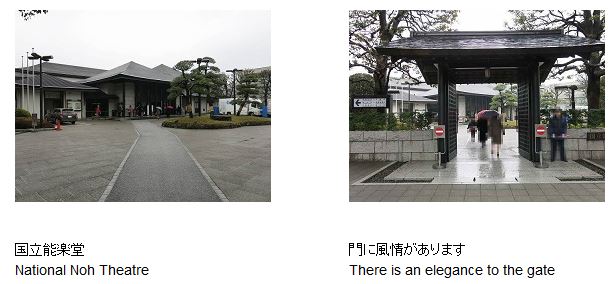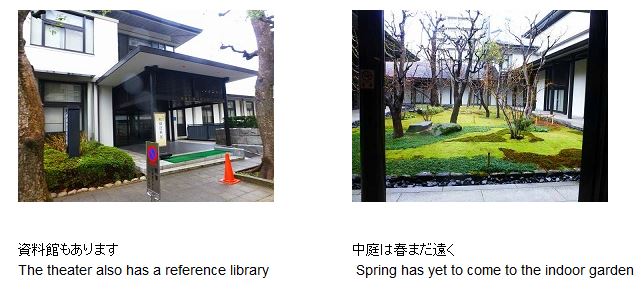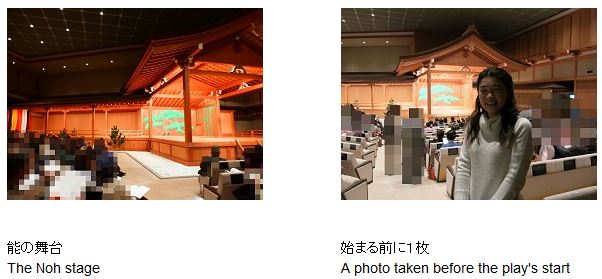Blogs edited and submitted by Chiho Kamioka
JOI Support staff and manager.
The World of Noh
能の世界 The world of Noh

By YANAKA Izumi
国立能楽堂へ能を見に行きました。
今までテレビや本で能の様子を見たことがありましたが、ちゃんとした舞台を見るのは初めてでした。
今回の演目は『忠度(ただのり)』と『道成寺(どうじょうじ)』です。
『忠度(ただのり)』は、源平の戦で亡くなった平忠度という人の話です。自分が作った和歌が歌集に載せられたのですが、敵の武将であったために、だれが読んだか分からない(詠み人知らず)とされました。それを残念に思った忠度は、幽霊となって現れ、やってきた旅の僧に自分の残念な思いや戦で亡くなるまでの話をするという話です。
『道成寺(どうじょうじ)』は、恋が叶わなかった娘の執念の物語です。好きになった男が道成寺という寺に逃げました。娘は毒蛇になって男を追いかけ、最後には男を隠れていた釣鐘といっしょに焼き殺してしまいます。ちょっと怖い話でしたが、この話では能の舞台に釣鐘がぶら下がるというおもしろい演出がありました。
話の内容を理解してから見ると、能もおもしろいです。それに今回はセリフが書いてあるパンフレットを見ながら舞台を見ていたので、何を言っているのかよくわかりました。今まで難しそうだと思って見に行かなかったのですが、これを機会にこれからは他の演目も見に行きたいと思います。
■To listen to this blog, please watch our Youtube video
★Kanji with hiragana
能(のう)の世界(せかい)
国立能楽堂(こくりつのうがくどう)へ能(のう)を見(み)に行(い)きました。
今(いま)までテレビや本(ほん)で能(のう)を見(み)たことがありましたが、ちゃんとした舞台(ぶたい)を見(み)るのは初(はじ)めてでした。
今回(こんかい)の演目(えんもく)は『忠度(ただのり)』と『道成寺(どうじょうじ)』です。
『忠度(ただのり)』は、源平(げんぺい)の戦(いくさ)で亡(な)くなった平(たいらの)忠度(ただのり)という人(ひと)の話(はなし)です。自分(じぶん)が作(つく)った和歌(わか)が歌集(かしゅう)に載(の)せられたのですが、敵(てき)の武将(ぶしょう)であったために、だれが読(よ)んだかわからない(詠(よ)み人(びと)知(し)らず)とされました。それを残念(ざんねん)に思(おも)った忠度(ただのり)は幽霊(ゆうれい)になって現(あらわ)れ、やって来(き)た旅(たび)の僧(そう)に自分(じぶん)の残念(ざんねん)な思い(おもい)や戦(いくさ)で亡(な)くなるまでの話(はなし)をするという話(はなし)です。
『道成寺(どうじょうじ)』は、恋(こい)が叶(かな)わなかった娘(むすめ)の執念(しゅうねん)の物語(ものがたり)です。好(す)きになった男(おとこ)が道成寺(どうじょうじ)という寺(てら)に逃(に)げました、娘(むすめ)は毒蛇(どくじゃ)になって男(おとこ)を追(お)いかけ、最後(さいご)には男(おとこ)を隠(かく)れていた釣鐘(つりがね)といっしょに焼(や)き殺(ころ)してしまいます。ちょっと怖(こわ)い話(はなし)でしたが、この話(はなし)では能(のう)の舞台(ぶたい)に釣鐘(つりがね)がぶら下(さ)がるというおもしろい演出(えんしゅつ)がありました。
話(はなし)の内容(ないよう)を理解(りかい)してから見(み)ると、能(のう)もおもしろいです。それに今回(こんかい)はセリフが書(か)いてあるパンフレットを見(み)ながら舞台(ぶたい)を見(み)ていたので、何(なに)を言(い)っているのかよくわかりました。今(いま)まで難(むずか)しそうだと思(おも)って見(み)に行(い)かなかったのですが、これを機会(きかい)にこれからは他(ほか)の演目(えんもく)も見(み)に行(い)きたいと思(おも)います。
★English Translation
The world of Noh
I went to the National Noh Theater to watch a Noh play.
I have watched Noh plays on television before but it was the first time for me see one on a proper stage.
This time's program was “Tadanori” and “Dou Jou Ji”.
“Tadanori” is a story about a person named Taira no Tadanori who died in the battle between the Minamoto clan and the Taira clan. He had written a Tanka poem which was included in anthology compiled by an enemy general, however in order to disguise who had read it, it was attributed to an anonymous poet.
The story goes that he felt dispointment over this turn of events, so he became a ghost and appeared to a travelling Buddhist priest and made him tell the tale of his disappointment and the battle until his death.
“Dou Jou Ji” is an implacable tale of the unrequited love of a young girl. The boy that she loves, runs away to a temple named Dou Jou Ji, so the girl turns into a poisonous snake and chases after the boy, finally in the end she burns and kills him along with the hanging temple bell in which he is hiding. It is a slightly scary story, but this story has an interesting stage direction which features a temple bell hanging on the Noh stage.
Watching Noh theater after you have understood the subject of the story can be really interesting. On top of this, I could read the lines of the play from a pamphlet while watching the play so I could clearly understand what was being said. Until now I hadn't been to see a play before because it looked difficult to comprehend, but using this opportunity as a starting point, I would like to go and see other programs in the future.
★This week's vocabulary
能(のう) Noh; the Noh play[drama]
世界(せかい) the world
ちゃんとした proper
舞台(ぶたい) stage
演目(えんもく) a program
源平の戦(げんぺいのいくさ) a battle between the Minamotos(Genji) and
the Tairas(Heike).
平忠度(たいらのただのり) Taira No Tadanori (1144-1184.3.20)
和歌(わか) waka; tanka; classic Japanese poem 31-syllable
歌集(かしゅう) a collection of tanka [poems]
武将(ぶしょう) a general; a military commander
詠み人知らず(よみびとしらず) anonymous ( it is not known who composed
this tanka )
幽霊(ゆうれい) a ghost
僧(そう) a Buddhist priest; a bonze
思い(おもい) an emotion; sentiment
叶わなかった(かなわなかった) unrequited
執念(しゅうねん) spite; a deep attachment
毒蛇(どくじゃ) a poisonous snake
釣鐘(つりがね) hanging bell in the temple
演出(えんしゅつ) direction
これを機会に(これをきかいに) taking this as an opportunity
Last modified on



